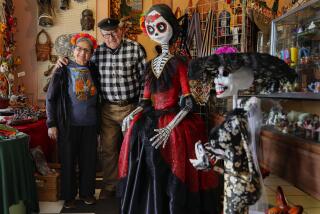Making Music Beautiful : Hand-Built Pipe Organ at Point Loma Church
- Share via
SAN DIEGO — In an era when giant computers compose music and robots quicken the pace of factory assembly lines, the pipe organ builder is a jarring anachronism.
Hand-crafting musical instruments according to methods perfected and codified roughly three centuries ago, as well as fashioning a unique design for every customer, organ builders such as Paul Fritts of Tacoma, Wash., seem lost in a time warp.
“The art of organ building reached its peak in sophistication, quality and musicality prior to the birth of J. S. Bach,” explained Fritts, who, with his partner Ralph Richards, has devoted his career to re-creating instruments from that remote era. “Their style of building valued economy--getting the most sound out of the pipes so that they would be rich, colorful and articulate.” Fritts and his crew are in San Diego installing their latest creation at All Souls’ Episcopal Church of Point Loma.
For those who rate organs merely in terms of size, the new Point Loma instrument will break no records. But as a faithful re-creation of the golden age of European organ building, it will have no peer in Southern California. Its sole accommodation to contemporary comforts is an electric blower to provide wind. In an era that frowns on child labor, a hand-pumped organ of this size would prove particularly impractical.
The only other major organ in the state built along such rigorous historical lines is the multimillion-dollar Charles Fisk organ installed last year in Stanford University’s Memorial Chapel.
Because the All Souls’ congregation has a history of strong arts involvement, it is not surprising that they placed a high priority on acquiring an instrument of this caliber. In 1974, the church’s music director, Hollace Koman, presented the first of four operettas in the church with an actors’ ensemble that later became the San Diego Gilbert and Sullivan Company.
“We chose this sort of instrument both to meet the musical needs of our parish and to broaden the resources available to the musical community of San Diego,” said the Rev. Ralph Carskadden, All Souls’ rector and an organist by avocation.
One of the benefits of this instrument to the local musical community will be the caliber of organ virtuoso it will attract. All Souls’ has already contacted Swiss organist Guy Bovet and Harald Vogel of the North German Organ Academy to perform on the new organ. Because of the dearth of fine organs in San Diego, neither organist has ever performed here. That the organ is tuned in Baroque fashion is an additional lure for organists who want to perform authentically music written before the 19th Century.
The scheduled arrival of the Fritts-Richards organ was sufficient to lure organist Robert Thompson from his teaching and performing duties on the music faculty of St. Olaf College in Northfield, Minn., to become director of music at All Souls’ earlier this year.
The organ is visually arresting, making a bold statement before emitting a single sound. Fritts explained that the shape of its case and overall design were inspired by 17th-Century Dutch and north German prototypes, although the detail work alludes to its Point Loma home.
While the delicate gilded filigree on most pipe organ cases is composed of abstract floral designs and an occasional plump cherub, this instrument is adorned with representations of sea life, appropriate symbols for a community that overlooks both the Pacific and San Diego Bay. Worked into the design and finished with 24-karat gold are shells, strands of seaweed, a sea horse, a squid, a lobster, a sculpin and one large crab--a Loxorhynchus grandis, a species found locally . A stylized starfish affixed to the tallest front pipe rotates when the organist engages the Zimbelstern , a fanciful device that produces an ostinato of bell sounds.
Although the architecture of the All Souls’ building is uncompromisingly 1960s modern, the builders mitigated the contrast between the stark white-painted brick walls and the ornate organ by constructing the organ case in the same redwood that is used decoratively in the vertical grillwork behind the organ. In addition to redwood, the instrument contains poplar, white oak, basswood and Honduras mahogany. On the keyboards, all of the sharp keys are made of ebony, and the natural keys are covered in cow shinbone.
“The bone will outlast ivory and won’t yellow,” Fritts replied when asked why the more traditional key covering was not used.
For those who relish statistics, the organ stands 22 feet tall and contains about 2,500 pipes, ranging in height from 16 feet to a few inches. It has three keyboards, or manuals, and a pedal board, each controlling a different division of the organ. Unlike most modern pipe organs that boast solid-state computerized mechanisms to permit the organist to change registrations with the push of a button, each of the 34 stops must be engaged and disengaged manually. The congregation paid just under $300,000 for the instrument, “not an overwhelming amount for an instrument that should last 200 years,” Carskadden said.
One of the lessons the All Souls’ congregation learned with their eight-year organ project was patience. It took about six years after the contract was signed with the builders for the instrument to be delivered. After a lengthy design process, the Fritts-Richards people began constructing the organ two years ago. The three-man installation crew arrived in mid-November and plans to have much of the organ playing by Christmas Eve. But the pedal division--that part of the organ that contains the lowest-sounding bass pipes--will not be shipped from Washington until January. By April, Thompson hopes to play the inaugural recital on the completed organ.
More to Read
The biggest entertainment stories
Get our big stories about Hollywood, film, television, music, arts, culture and more right in your inbox as soon as they publish.
You may occasionally receive promotional content from the Los Angeles Times.










